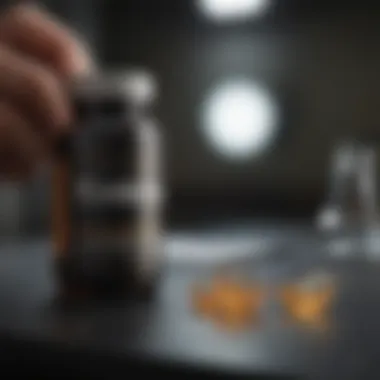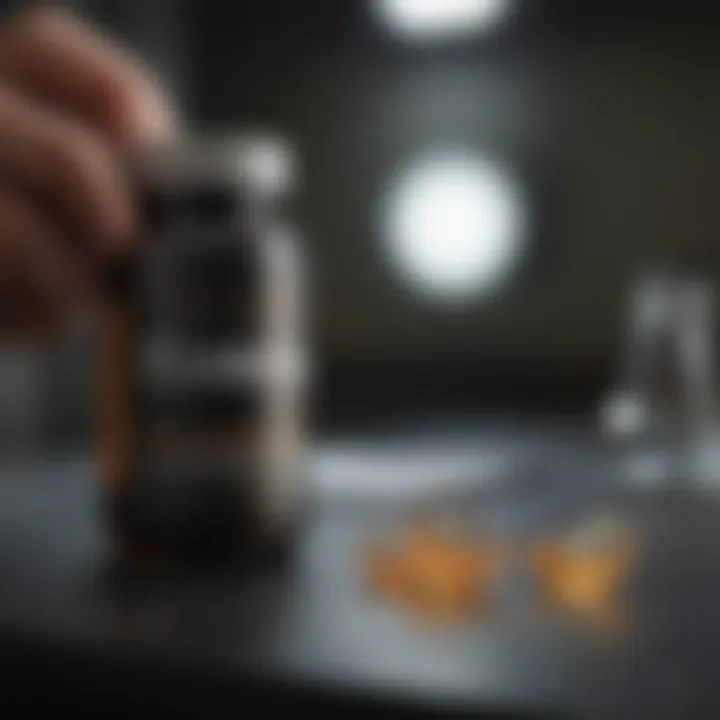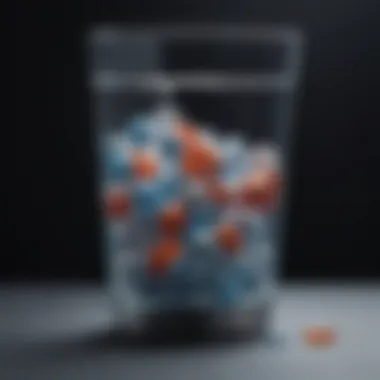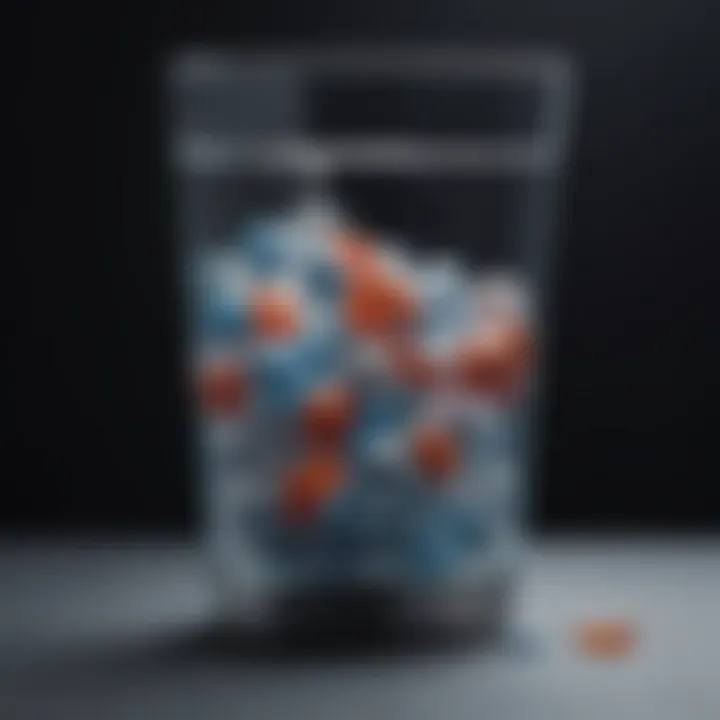Guidelines for Administering Orally Disintegrating Tablets


Intro
Orally disintegrating tablets (ODTs) have gained significant attention in the pharmaceutical field. These innovative formulations dissolve quickly in the mouth without the need for water, providing a unique method of drug delivery. This article aims to establish guidelines for the effective administration of ODTs. Understanding the nuances of this method is crucial for healthcare professionals, patients, and caregivers alike. In this exploration, we will delve into the methodology behind ODTs, the advantages they offer, and the specific recommendations for their usage.
The following sections will cover the conceptual framework surrounding ODTs, address potential challenges, and elucidate their relevance in enhancing patient compliance. As we delve deeper, we will discuss methodologies that have been used in research and clinical practice related to ODTs.
Understanding Orally Disintegrating Tablets
Orally disintegrating tablets (ODTs) represent a significant advancement in pharmaceutical delivery methods. Understanding ODTs is crucial for ensuring their effective use in clinical practice. Unlike traditional tablets, ODTs dissolve rapidly in the mouth, eliminating the need for water. This feature is especially beneficial for patients who might have difficulty swallowing, such as the elderly or young children.
The design of ODTs incorporates specialized excipients that enhance the rate of disintegration. This allows for quicker absorption of the active ingredient. The benefits of ODTs are numerous; they can lead to increased patient compliance due to their ease of use. Furthermore, swift absorption can enhance therapeutic outcomes, making them a practical option for various medical conditions.
Definition and Features
Orally disintegrating tablets are solid dosage forms that disintegrate rapidly upon contact with saliva. They are formulated to dissolve in the mouth, releasing the active pharmaceutical ingredient for absorption through the oral mucosa. Their structure is porous, allowing them to absorb moisture and dissolve quickly.
Some crucial features include:
- Ease of administration: ODTs do not require water, which benefits patients with limited access to liquids.
- Taste masking: Many formulations include flavoring agents, improving palatability for users.
- Convenience: They can be taken discreetly, making them suitable for various settings, including schools and workplaces.
Mechanism of Action
The mechanism of action of orally disintegrating tablets involves several processes. Initially, saliva interacts with the tablet upon placement on the tongue. This interaction leads to rapid disintegration of the tablet matrix. As it disintegrates, the active compound is liberated and can proceed to be absorbed through the buccal mucosa.
The pharmacokinetics of ODTs allows for the systemic circulation of drugs without first-pass metabolism. This can result in a faster onset of action compared to traditional oral dosage forms. Consequently, patients may experience quicker therapeutic effects, which is particularly critical in emergency situations or when rapid relief is required.
Understanding ODTs and their mechanisms is imperative for healthcare professionals. Proper knowledge facilitates informed decisions regarding patient selection and administration techniques, enhancing overall therapeutic effectiveness.
The Benefits of Orally Disintegrating Tablets
Orally disintegrating tablets (ODTs) offer a unique set of advantages that make them an important component of modern medication delivery systems. Their design caters to patient needs, ensuring both compliance and efficacy. This section dives into the numerous benefits of ODTs, illustrating how these features influence therapeutic outcomes and patient experiences alike.
Enhanced Patient Compliance
One of the foremost benefits of ODTs is the enhancement of patient compliance. Traditional oral medications can be unappealing for various reasons – difficulty swallowing, taste aversions, or the inconvenience of needing water to ingest them. ODTs dissolve quickly in the mouth without the need for water, significantly improving the likelihood that patients will take their medication as prescribed. This is particularly important for patients suffering from chronic conditions who require long-term treatment.
Studies have shown that when patients are provided with medications in forms that are easier to ingest, compliance rates can increase substantially.
Additionally, ODTs often have a taste-masking technology, which can improve the overall palatability of medications. The ease of using these tablets can reduce anxiety from taking medication, which is crucial in populations such as children and the elderly who may be more resistant to conventional forms.
Rapid Disintegration and Absorption
The ODTs are designed to rapidly disintegrate in the oral cavity, which leads to quicker absorption into the bloodstream. This is particularly beneficial for medications that require a prompt response, such as pain relief or anti-anxiety treatments. When ODTs dissolve, their active ingredients can enter the systemic circulation more swiftly than traditional tablets or capsules.
This rapid onset of action can significantly enhance the therapeutic effectiveness of the medication. For certain drugs, this means greater immediate relief and improved management of acute symptoms, which is vital in acute care settings. Moreover, the quick disintegration can facilitate a more consistent therapeutic level in patients who require stable medication management.
Convenience for Dysphagic Patients
Dysphagia, or difficulty swallowing, affects a notable portion of the population, including elderly individuals and those with neurological conditions. For these patients, traditional tablets can pose significant challenges. ODTs present a viable alternative, allowing them to receive necessary medications without the stress of swallowing large pills.
By removing the barriers associated with swallowing solid dosage forms, ODTs promote better health outcomes among dysphagic patients. Their design directly addresses the needs of individuals who might otherwise struggle with medication adherence. This convenience fosters a sense of autonomy for patients, as they can easily manage their prescriptions without needing assistance.
In summary, the benefits of orally disintegrating tablets extend across various patient demographics, significantly impacting medication adherence, therapeutic response times, and overall convenience for individuals with special needs. Their innovative design and practical features underscore their relevance in contemporary medicine, serving as essential tools for healthcare providers aiming for improved patient outcomes.
Selecting the Right Orally Disintegrating Tablet
Choosing the appropriate orally disintegrating tablet (ODT) is crucial to ensure therapeutic effectiveness and enhance patient compliance. This section will delve into factors that healthcare providers and patients must consider when selecting ODTs, focusing on the roles of consultation with healthcare professionals and understanding dosages and formulations. Making an informed decision can lead to better outcomes in therapeutic regimens.


Consultation with Healthcare Providers
Engaging in a dialogue with healthcare providers before selecting an orally disintegrating tablet is essential. Physicians, pharmacists, and other healthcare professionals can offer personalized advice based on a patient’s medical history, current medications, and specific health needs.
Factors to discuss include:
- Existing Medical Conditions: It is critical to evaluate how the chosen tablet interacts with any pre-existing conditions.
- Current Medications: Certain medications may interact negatively with ODTs. A thorough medication history is necessary.
- Individual Preferences: Some patients may have preferences regarding taste, texture, or ingredients—something that healthcare providers can help address.
By fostering open communication, patients can make choices that resonate with their treatment goals while decreasing the likelihood of adverse reactions.
Understanding Dosage and Formulations
Dosage and formulation significantly impact how the orally disintegrating tablet works and its effectiveness. ODTs come in various dosages, and understanding the precise requirements for a specific patient is vital.
Each ODT may have different:
- Concentrations: The amount of active ingredient in each tablet can vary. Correct dosage minimizes risks of under-treatment or overdose.
- Release Mechanism: Some ODTs are designed to dissolve rapidly, offering quick absorption, while others may have a slower dissolution rate. Knowing this helps manage therapeutic timelines effectively.
- Ingredients: Some patients may be sensitive to certain excipients or preservatives. It's important to review the full ingredient list to avoid any allergic reactions.
"Selecting the right orally disintegrating tablet is not just about effectiveness; it also considers patient comfort and adherence to therapy."
Preparing for Administration
Preparing for the administration of orally disintegrating tablets (ODTs) is a critical step in ensuring their effectiveness and maximizing patient comfort. Proper preparation can enhance patient compliance, facilitate a smoother administration process, and ensure the safety of the therapy. By taking the time to properly prepare, healthcare providers and caregivers can address specific needs and situations that may arise during administration.
Assessing Patient Readiness
Assessing patient readiness involves evaluating various factors that contribute to the successful administration of ODTs. This includes determining the patient's ability to understand and comply with the instructions for taking the tablet. Observing the patient's cognitive status can provide insights into their readiness. It is crucial to check if they are able to follow the steps of removing the tablet, placing it on the tongue, and waiting for it to dissolve.
In addition, the patient’s physical state is important. For instance, conditions like dry mouth or difficulty swallowing may pose barriers. It is vital to discuss these factors with patients, allowing them to express any concerns they may have regarding the medication.
Creating an Optimal Environment
An optimal environment ensures that the administration of ODTs occurs with minimal distractions and potential issues.
Factors to consider include:
- Quiet Space: A calm, quiet area can reduce anxiety and help the patient focus on the administration process.
- Temperature Control: Ensure that the room is at a comfortable temperature. Extreme heat or cold can cause discomfort.
- Accessibility: The setting should be free of obstacles. The tablet should be within reach, eliminating unnecessary movement that can disrupt the process.
Taking these elements into account when preparing for administration can lead to a more positive experience for the patient and increase the likelihood of successful medication intake.
"Creating a supportive environment not only aids in the administration of the tablet but also reassures the patient about the treatment process."
In summary, assessing patient readiness and creating an optimal environment are integral parts of preparing for the administration of orally disintegrating tablets. These steps can lead to effective use of the medication and improved patient dietary compliance.
Step-by-Step Administration Guide
Administering orally disintegrating tablets (ODTs) requires precision and understanding of the method involved. The importance of this step-by-step guide lies in its potential to maximize the efficacy of medication. Proper administration can enhance patient experience and ensure the drug is utilized effectively, offering important therapeutic benefits. In the process, certain considerations must be kept in mind regarding patient comfort and adherence.
Removing the Tablet from Packaging
Before administration, ensure that you carefully remove the tablet from its packaging. The packaging is designed to protect the tablet's integrity and efficacy until administration. Avoid touching the tablet surface with your fingers as this risks contamination, which can alter its effectiveness. Instead, one should grasp the edge of the blister pack gently. This method reduces the risk of damaging the tablet and helps maintain the sterility necessary for proper administration.
Placing the Tablet on the Tongue
Once the tablet is free from its packaging, place it directly onto the patient's tongue without chewing or swallowing it immediately. It’s critical to demonstrate proper placement to ensure the tablet is allowed to begin disintegrating naturally. Patients should be made aware that they may feel a pleasant sensation as the tablet dissolves, which is part of its designed function. This direct approach not only aids in quick absorption but also ensures effective delivery of the active ingredients to the system.
Allowing Time for Disintegration


Administering ODTs involves a necessary waiting period for disintegration. ODTs dissolve in saliva and need several seconds to a couple of minutes for complete disintegration, depending on the specific formulation. Instruct the patient to avoid swallowing until the tablet has fully dissolved. This step is vital as swallowing too early can prevent the drug from being fully absorbed, potentially diminishing its therapeutic effects. Educating patients on this timing can significantly impact overall effectiveness.
Swallowing Option
After the tablet has dissolved adequately, the patient may swallow the remaining particles or any fluid if needed. For those who prefer, they can wash down the remains with water, but this may not be necessary as ODTs are designed for a quick onset of action without additional fluids. Special considerations should be communicated to patients regarding how to handle the tablet remnants. Encourage them to trust the process of disintegration to experience optimal benefits from their medication.
Proper administration of ODTs can enhance medication efficacy and ultimately improve patient outcomes.
Considerations for Special Populations
Understanding the unique needs of special populations when administering orally disintegrating tablets (ODTs) is crucial. These populations include pediatric patients, geriatric patients, and individuals with cognitive impairments. Each group presents distinct challenges and considerations, which can significantly affect medication adherence and overall therapeutic outcomes.
Pediatric Patients
Administering ODTs to pediatric patients necessitates careful attention. Children may struggle with swallowing tablets, even those designed to dissolve quickly. ODTs can provide a more palatable alternative, minimizing distress during administration. Healthcare providers must assess a child's developmental stage and ability to handle medications. Clear guidance on dosage is essential, as children often require lower doses based on their weight.
Parents and caregivers play a pivotal role in this process. They should be educated on the correct administration method, which includes ensuring the ODT is placed on the tongue without delay. The flavor of the ODT may also influence acceptance among younger patients; flavored options can enhance compliance.
Geriatric Patients
Geriatric patients often face unique challenges, such as difficulty swallowing, xerostomia, or other swallowing disorders. ODTs may be especially beneficial in this demographic, allowing for quicker absorption without the need for water. Healthcare professionals must assess each patient’s overall health status to determine if ODTs are appropriate. For some, the texture and taste of these tablets may pose issues. As taste preferences can vary, discussions about different formulations are necessary to ensure acceptance.
Additionally, older adults often take multiple medications, leading to potential drug interactions. It’s vital for healthcare providers to coordinate with pharmacists and other caregivers to monitor for adverse effects and efficacy.
Patients with Cognitive Impairments
For patients with cognitive impairments, administering medications can be complicated. ODTs can simplify the process. These patients may forget to take their medications or find it difficult to follow complex instructions. Therefore, education tailored to the individual’s cognitive level is necessary. It’s also important for caregivers to establish a routine that incorporates ODTs into daily activities, enhancing compliance.
Consideration of the patient's preferences is key. Some patients may have textures or flavors they dislike; providing choices can foster acceptance and make administration smoother. Caregivers should also be vigilant about observing any changes in health or behavior following ODT administration, as they may indicate issues related to medication effectiveness or side effects.
Understanding the specific challenges faced by these special populations allows for better management of ODT administration. Adequate training and resources for caregivers enhance the overall effectiveness of treatment.
Challenges in Administration
The successful administration of orally disintegrating tablets (ODTs) comes with its own set of challenges. Recognizing these challenges is essential for maximizing therapeutic efficacy and ensuring patient compliance. Addressing difficulties within this context not only improves the patient experience but also influences clinical outcomes. The attention to detail in managing these factors provides insight into the nuances of ODT administration, which is particularly relevant in both clinical and home environments.
Avoiding Contamination
One significant challenge in the administration of ODTs is the risk of contamination. Since these tablets are designed to dissolve in the mouth without water, they are particularly susceptible to contamination from various sources. Handling by multiple individuals, exposure to moisture, and contact with unclean surfaces add layers of complexity to this issue.
To mitigate these risks, healthcare providers and caregivers must abide by strict hygiene protocols. Here are some guidelines to consider:
- Wash Hands: Thorough handwashing before handling ODTs is crucial. Ensuring cleanliness helps limit the introduction of pathogens to the tablet.
- Minimize Exposure: When opening the packaging, it is essential to avoid touching the surface of the tablet. Positioning the tablet gently onto the tongue helps prevent contamination.
- Single-Use: Whenever possible, ODTs should be administered one at a time without sharing between patients. This preserves the tablet's integrity and minimizes the risk of cross-contamination.
By maintaining rigorous standards for contamination control, stakeholders can enhance the safety and reliability of orally disintegrating tablets.
Dealing with Texture Preferences
Texture can be another barrier to effective administration. Each patient has unique preferences and aversions to certain mouthfeel or consistency of medications. ODTs often present a distinct texture that may not be suitable for everyone. Individual differences can lead to reluctance in taking the tablets, ultimately affecting adherence to treatment regimens.
To navigate this challenge, understanding patient psychology and preferences becomes necessary. Here are several strategies that may help:
- Education: Discussing the benefits of ODTs openly with patients can help them appreciate their value. Understanding why the tablet has a specific texture can sometimes alleviate concerns about taste or feel.
- Flavor Options: Whenever available, select ODTs that offer various flavors to cater to different preferences. This can greatly improve patient experience and compliance.
- Trial: Encourage patients to try the ODTs gradually. A little exposure can assist them in getting used to the texture. Addressing their initial worries can empower them towards acceptance.
In summary, addressing challenges in the administration of orally disintegrating tablets is paramount. By prioritizing contamination prevention and sensitivity towards texture preferences, healthcare providers can significantly improve the efficacy and adherence related to this unique medication format.
Storage and Handling of ODTs


Proper storage and handling of orally disintegrating tablets (ODTs) are essential to maintain their efficacy and safety. These tablets are designed for rapid dissolution in the mouth, offering convenience for patients who may experience difficulties with traditional oral dosage forms. Understanding how to store and manage these tablets can help ensure that their therapeutic benefits are not compromised due to improper conditions. Key points to consider include temperature sensitivity, humidity control, and adhering to expiration dates.
Temperature Considerations
ODTs are sensitive to temperature variations. It is crucial to store them at a consistent temperature, usually between 15°C to 30°C (59°F to 86°F), depending on the manufacturer's specifications. Extreme heat can lead to melting or structural degradation, while cold temperatures can affect the compression integrity of the tablets.
When storing ODTs, avoid locations close to heat sources, such as radiators or direct sunlight, as these can raise the temperature unexpectedly. One should also keep ODTs in their original packaging until right before use. This helps prevent exposure to moisture and air, both of which can alter the tablet’s quality. In some cases, refrigeration may be recommended, but this should only be done if specified in the product guidelines.
Shelf Life and Expiry Dates
Shelf life is a critical factor when it comes to ODTs. These tablets usually have specific expiry dates assigned by the manufacturer, indicating the period during which they are guaranteed to remain effective and safe. After the expiration date, ODTs may not offer the desired therapeutic effect.
It is crucial to check the packaging for expiry dates before administering. Following proper storage methods can help maximize shelf life. Typically, ODTs should be stored in a cool, dry place, away from light and moisture. If the packaging is opened, the recommended shelf life may be shortened. Therefore, it is advisable to consume ODTs within a reasonable time frame after opening, adhering to the guidelines provided by the manufacturer.
"Pharmaceuticals, including orally disintegrating tablets, rely heavily on correct storage methods to ensure their effectiveness. Mismanagement can lead to wasted resources and compromised patient health."
Interactions and Contraindications
Understanding the interactions and contraindications associated with orally disintegrating tablets (ODTs) is crucial for safe and effective patient management. This section will detail the unique challenges presented by these medications and the necessity of a comprehensive overview for healthcare professionals, patients, and caregivers. ODTs, while generally convenient, can have specific interactions with other medications or underlying medical conditions that could affect their efficacy or cause adverse reactions. Recognizing these factors enhances patient safety and treatment outcomes.
Drug Interactions
Drug interactions can significantly impact the effectiveness of orally disintegrating tablets. When multiple medications are prescribed, there is a possibility that one drug may alter the absorption, metabolism, or elimination of ODTs. For instance, certain drugs may inhibit or induce liver enzymes responsible for metabolizing the active ingredients in ODTs. This can lead to either increased side effects or reduced therapeutic effects.
Some common examples of drug interactions include:
- Antibiotics: Certain antibiotics, such as rifampin, can decrease the concentration of the active ingredient in ODTs, possibly resulting in therapeutic failure.
- Antidepressants: Medications like fluoxetine may lead to augmented side effects when combined with ODTs containing similar active compounds.
- Antihypertensive Agents: Using ODTs along with medications to manage blood pressure may result in exaggerated blood pressure changes.
Patients should always inform their healthcare provider of all medications, supplements, and herbal products they are taking. Regular medication reviews can help minimize the risk of interactions and ensure that ODT administration is safe and effective.
Medical Conditions to Consider
Certain medical conditions can complicate the administration of orally disintegrating tablets. When prescribing ODTs, healthcare professionals must consider how specific health issues may affect drug absorption and efficacy.
Conditions that warrant careful consideration include:
- Renal Impairment: Patients with kidney issues may have altered drug elimination, impacting how ODTs function in their bodies. Dosage adjustments may be necessary.
- Hepatic Disorders: Liver diseases can affect drug metabolism and the efficacy of ODTs, leading to increased toxicity or decreased effectiveness.
- Gastrointestinal Disorders: Conditions such as achalasia or severe GERD can hinder the disintegration and absorption of the ODT, affecting the overall treatment plan.
Key Considerations for Healthcare Providers:
- Review the patient's complete medical history and current conditions before prescribing ODTs.
- Monitor patient progress closely for any signs of reduced efficacy or adverse reactions associated with ODTs.
- Engage in shared decision-making, ensuring patients understand their treatment options, including potential risks and benefits of ODTs in the context of their health status.
"A thorough understanding of drug interactions and medical conditions is essential for optimizing treatment with orally disintegrating tablets."
The goal is to promote a more effective therapeutic approach while safeguarding patient welfare. This emphasis on diligence and care underlines the inherent complexities of administering ODTs.
Ending
The conclusion section serves as a vital component of the article on administering orally disintegrating tablets. It synthesizes the essential insights gained throughout the discussion, reinforcing the significance of correctly applying the provided guidelines in clinical practice.
This section emphasizes that adherence to best practices can greatly enhance patient compliance and therapeutic outcomes. Specifically, the effectiveness of ODTs is integrated with the need for proper administration techniques. Any lack of attention to these methods may obstruct the intended benefits of the medication, potentially leading to negative health implications.
Key elements discussed earlier include understanding patient readiness, managing the storage conditions, and recognizing possible drug interactions. Through a structured approach, healthcare professionals, educators, and caregivers can ensure that the administration of ODTs is both safe and effective, reducing the risk of misadventures associated with misadministration.
By focusing on these aspects, the article contributes to establishing a reliable framework for all stakeholders involved, ultimately aiming to improve health outcomes across various patient populations.
Summary of Key Points
- Orally disintegrating tablets offer unique advantages in drug delivery.
- Understanding the mechanism of action is essential for effective use.
- Assessing patient readiness ensures proper administration.
- Adhering to storage and handling guidelines maximizes efficacy.
- Awareness of potential drug interactions is crucial for patient safety.
- Final guidance helps to reinforce best practices in administering ODTs.
Final Thoughts on ODT Administration
Moreover, recognizing the specific needs of diverse patient groups such as pediatrics and geriatrics can enhance the therapeutic experience. It is crucial that all stakeholders, including learners and researchers, remain informed about the latest practices surrounding ODT administration.
By understanding the nuances of ODTs, we can significantly elevate the standard of care delivered in various healthcare settings.







